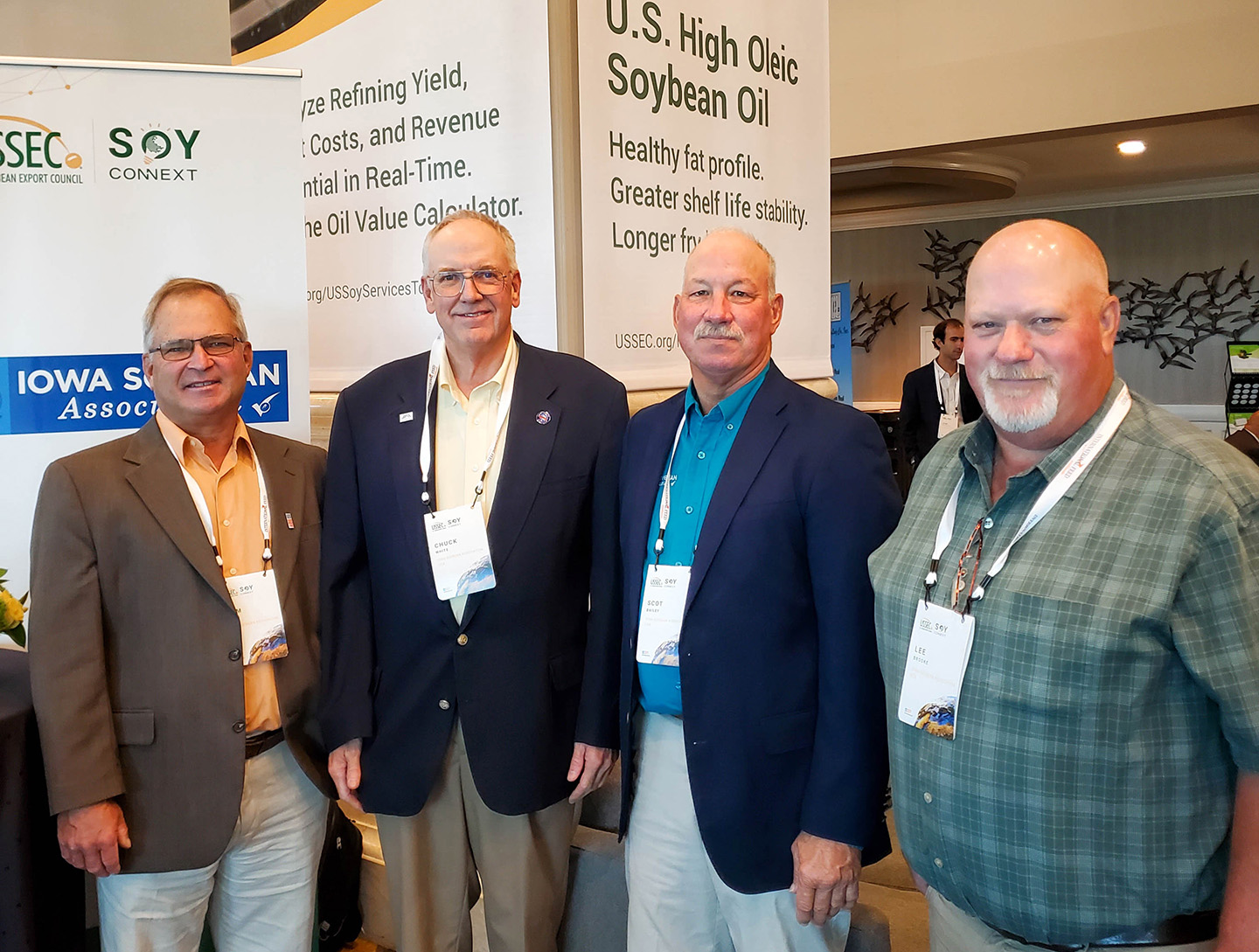
Chuck White of Spencer, Scot Bailey of Anita, Tom Adam of Harper and Lee Brooke of Clarinda (Photo: Aaron Putze/Iowa Soybean Association)
China soy demand challenged, inflation here to stay say oilseed experts
August 31, 2022 | Aaron Putze, APR
More than 600 soybean farmers, purchasers and processors representing 64 countries gathered last week in San Diego for the U.S. Soybean Export Council’s global soy exchange.
Dubbed “Soy Connext,” the event offered Iowa and U.S. soybean farmers a timely opportunity to market and promote U.S. soy, the families who sustainably grow the oilseed and the product’s quality.
Iowa soybean farmers attending included Chuck White of Spencer, Scot Bailey of Anita, Tom Adam of Harper and Lee Brooke of Clarinda.
The two-day summit featured more than a dozen speakers who shared information via keynotes and breakout sessions.
Overheard from the podium…
“Inflation is driving the macro economy. It was something ignored by the U.S. Fed when it said that inflation was temporary and transitory. It is neither. The delay in action caused economic chaos and a trainwreck. Now the feds are increasing interest rates to see inflation be reduced and exit.”
– Matt Ammermann, VP Eastern Europe/Black Sea Region, StoneX
“I’m exceptionally concerned about China’s economic well-being. It literally makes the hair on the back of my neck stand up.”
– Emily French, Global Ag Protein President and Founder
“Chinese leadership seeks stability. But that’s easier said than done as its population ages and economy slows. (U.S. Speaker of the House Nancy) Pelosi’s ill-advised visit to Taiwan and China’s reaction was not helpful. Agricultural exports are not exempt from politics.”
– Anja Manuel, co-founder and partner, Rice-Hadley-Gates and Manuel LLC
“Roughly 75% of the U.S. soybean growing region has escaped drought. Our geographic and soy’s genetic diversity along with the ingenuity of the U.S. farmer, allows the U.S. to be a resilient and dependable producer of soy for the world.”
– Mac Marshall, VP Market Intelligence, United Soybean Board, U.S. Soybean Export Council
“China’s economy has been a north star for agricultural exports. Long-term trends for continued growth in China are ebbing, from 10% annually to perhaps 4-5%. It may reach its peak population this year and will begin to decline. More elderly Chinese and shrinking working population that will need to take care of them will adversely impact its reliance on agricultural imports.”
– Anja Manuel
The U.S. crush industry is very bullish; up 30% through 2028; this will create added soybean meal which will need to find a home. Soybean meal has a unique and bullish market which means we’ll find a home for the product.
– Matt Ammermann
“Any hiccup with the Brazilian crop next year caused by weather issues means substantially higher prices and one of the most impactful black swan events.”
– Matt Ammermann
“When you go back to 1965 when the world population was 3 billion, ag goods were nearly twice as high as they are today in relative to the price of other goods. Food is less expensive today with a population of 7.2 billion and with each person eating almost 50% more calories than just 40 years ago.”
– Erik Norland, Executive Dir. and Sr. Economist, CME Group
“All of us have a shared responsibility – to achieve zero hunger on this planet. The soybean industry is committed to collaborating with you to advance nutrition and food security and environmental sustainability while improving the livelihoods of all who live on this planet.”
– Jim Sutter
“Europe’s energy crisis is real and there are no good short-term solutions.”
– Anja Manuel
“Over next 3-5 years, the thing to watch is the Black Sea and Ukraine/Russia war. We all want to see it end but will continue to have far-reaching implications. If the war gets worse and further impacts the farmers ability to plant and harvest, it will continue to create major turmoil globally.”
– Matt Ammermann
“The world is urbanizing and a fast rate – about 80 million people annually, many of whom are transitioning from growing food to buying food. This trend is expected to continue for the next 30 years. We need to add about 8-9 million tons of soy just to meet the demand for protein from those who are urbanizing.”
– Marty Ruikka, President, The Pro-Exporter Network
“I’m very worried about China. The country is experiencing a very severe financial crisis. China has accumulated massive amounts of debt (both personal and governmental). Housing prices in China are crashing. China’s bond yields are soaring which means it’s going to be almost impossible to finance its large amount of debt. In the short term, China is going to begin devaluing its currency. The Chinese currency is at great risk of declining significantly. The tremendous rise in inflation is not causing many agricultural products to rise because of China’s slowing economy.”
– Erik Norland
“Every soybean needs to be crushed. If we grow demand 8-9 mmt/year, we need to grow crush by that much. The expanded demand and increased margins have resulted in crush expansion taking place in the U.S. This isn’t odd or extraordinary as we hadn’t seen a lot of crush expansion in the U.S. for quite some time.”
– Marty Ruikka
“During volatile times, working with people you trust is critical. That’s where the importance and value of relationships is manifested.”
– Jim Sutter, CEO, U.S. Soybean Export Council
Back